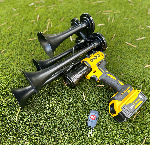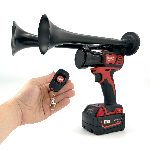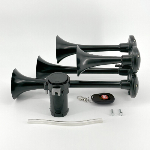Sound is a powerful force that can travel surprising distances. In fact, the human ear can detect sounds as low as 0 decibels, equivalent to the sound of a pin dropping. However, when it comes to the thunderous roar of a train, the question arises: just how far away can you hear it?
Trains have been an integral part of transportation for centuries, dating back to the steam-powered locomotives of the early 19th century. Back then, the huffing and puffing of these iron beasts could be heard from considerable distances, alerting villages of their impending arrival. But as technology advanced and train engines became more efficient, their noise levels decreased significantly.
Today, modern trains are designed with noise reduction in mind. With insulated cabins and specially engineered wheels, the rattling and rumbling have been minimized, creating a more comfortable experience for passengers. Yet, despite these advancements, trains can still produce remarkable levels of sound energy.
Just how far this sound travels depends on a multitude of factors. The surrounding environment plays a crucial role, as sounds tend to carry further in open spaces compared to urban settings. Weather conditions also come into play, with sound waves traveling differently in still air versus windy conditions.
Another variable to consider is the type of train. High-speed trains, like the famous Japanese Shinkansen, are equipped with aerodynamic designs and streamlined bodies that minimize noise. On the other hand, traditional locomotives with their iconic chugging engines may produce more audible sounds, especially when passing through quiet rural areas.
While it is difficult to pinpoint an exact distance at which trains can be heard, studies have shown that the average audible range is around 1 to 2 miles. However, certain factors can extend this range significantly. For instance, if a train passes through a canyon or a flat landscape with minimal obstructions, the sound waves can travel much farther.
Ultimately, the audibility of a train largely depends on the specific circumstances and individual hearing abilities. It is worth noting that some individuals may perceive sounds differently, with factors such as age and ambient noise further influencing our perception.
Next time you find yourself in the vicinity of train tracks, take a moment to appreciate the science of sound. Whether you hear the distant rumble or the gentle whistle, it serves as a reminder of the incredible power and reach of this everyday phenomenon.
What is the Distance at Which Trains Can Be Audibly Detected?
Trains are a fascinating mode of transportation admired by many. One common curiosity is how far away one can hear the sound of a train approaching. Understanding the range of audibility of trains can be valuable for various reasons, such as ensuring safety near railway tracks or providing insights into noise pollution. In the following section, we will explore the factors influencing the distance at which trains can be heard, including train speed, environmental conditions, and the type of surroundings. By delving into these aspects, we will gain a comprehensive understanding of the range of audibility and the factors that affect it. So, let's embark on this auditory journey!
Factors that Affect the Audibility of Trains
Several factors influence how far away you can hear a train. Understanding these factors can help give you an idea of the audible range of trains.
- Train Type: The type of train plays a significant role in how far its sound can travel. Trains with steam engines tend to produce louder and more distinctive sounds compared to modern diesel or electric trains.
- Speed: The speed at which a train is traveling affects the audibility. As a train accelerates, the sound waves it produces have a higher frequency and can travel longer distances. Slower trains may not create as much noise or carry it as far.
- Environmental Conditions: The environment in which you're listening to a train also impacts the audibility. Sound travels differently in various weather conditions, such as on a calm day compared to a windy day. Additionally, the presence of obstacles like buildings or vegetation can affect how far the sound can travel.
- Track Design: The design of the railway track can influence the audibility of trains. For example, curved tracks can create reflective surfaces that amplify the sound. Additionally, the presence of tunnels or bridges can impact how the sound waves propagate.
How Sound Travels
To understand the distance at which a train can be heard, it is essential to have a basic understanding of how sound travels. Sound is a form of energy that travels in waves through a medium, typically air. The distance sound can travel depends on its frequency, amplitude, and the characteristics of the medium it travels through.
When a train moves, it generates sound waves that propagate through the air. These waves consist of compressions and rarefactions, which create changes in air pressure. The human ear detects these pressure changes as sound.
The audibility of sound depends on several factors. For instance, higher frequencies tend to attenuate or decrease in intensity more quickly as they travel through the air. Lower frequencies, on the other hand, have a longer wavelength and can travel greater distances.
Audible Range of Trains
The audible range of a train varies depending on the factors mentioned above. On average, you can hear a train approaching from around 1 to 2 miles away, especially if the train is traveling at higher speeds or has a distinct sound.
However, it's important to note that this range can be affected by environmental conditions. For example, on a calm day with no obstacles, you may hear a train from further away. Conversely, in a noisy urban environment or during inclement weather, the audible range may be reduced.
Statistics on Train Audibility
While the audibility of trains can vary, here are some statistics to provide an overview:
- In open, rural areas with minimal obstacles, a train whistle can typically be heard from 1 to 2 miles away.
- In urban areas with more ambient noise and obstructions, the audible range may be limited to a few hundred yards.
- Steam trains are generally louder and can be heard from greater distances compared to diesel or electric trains.
- The type of track, such as curved sections or those with reflective surfaces, can enhance the audibility of a train's sound.
https://youtube.com/watch?v=Bkc3P2SaDLs
FAQ: How Far Away Can You Hear a Train?
Question 1: What factors affect how far away a train can be heard?
Trains generate a significant amount of noise, but several factors contribute to how far their sound travels.
Answer 1:
The factors that affect how far away a train can be heard include the train's speed, the landscape it travels through, and the environmental conditions.
Important information:
1. Train speed: The faster a train is moving, the louder its noise will carry over a distance.
2. Landscape: The terrain, surrounding structures, and natural barriers can either amplify or dampen the sound of a train.
3. Environmental conditions: Factors such as wind speed and direction, temperature, and humidity can affect how far the sound of a train travels.
Question 2: Does the type of train affect how far its sound carries?
Different types of trains produce variable amounts of noise, which can impact how far away their sound can be heard.
Answer 2:
The type of train influences how far its sound carries due to variations in design, engine specifications, and the type of tracks it runs on.
Important information:
1. Design: The aerodynamic design of the train can significantly reduce noise levels, allowing for quieter operation.
2. Engine specifications: The engine power and exhaust system of a train can impact the intensity and range of its sound production.
3. Track type: Trains operating on different track types, such as concrete or wooden ties, may produce distinct noise levels that affect their audible range.
Question 3: Can weather conditions affect how far away a train can be heard?
Weather conditions play a considerable role in the propagation of sound, including the sound of a passing train.
Answer 3:
Yes, weather conditions can influence how far away a train can be heard, primarily due to the effects of wind speed, temperature, and humidity.
Important information:
1. Wind speed and direction: A strong headwind can carry the sound of a train farther, while a tailwind may hinder its audibility.
2. Temperature: Changes in temperature affect the speed of sound waves, which can either enhance or impede their transmission over distance.
3. Humidity: High humidity levels in the air can absorb sound waves, diminishing the distance at which a train can be heard.
Question 4: How does the time of day affect the audibility of a passing train?
The time of day can have an impact on how far away a train's sound can be heard due to various factors related to human activities and atmospheric conditions.
Answer 4:
The audibility of a passing train can be influenced by the time of day, as it affects factors such as ambient noise levels and temperature inversion.
Important information:
1. Ambient noise levels: During busy periods or in urban areas, there may be higher levels of background noise, which can mask or reduce the audibility of a train.
2. Temperature inversion: In certain atmospheric conditions, sound waves can become trapped close to the ground, reducing their range and making it harder to hear a train at a distance.
3. Nighttime conditions: During nighttime, when overall noise levels are typically lower and atmospheric conditions may be more stable, the sound of a train can travel further.
Question 5: How does the presence of obstacles influence the audibility of a train?
Obstacles along the path of a train can affect how far its sound travels, either by attenuating or reflecting the sound waves.
Answer 5:
The presence of obstacles along the path of a train can impact the audibility of its sound due to factors like sound absorption, reflection, and diffraction.
Important information:
1. Sound absorption: Obstacles such as vegetation, buildings, or hills can absorb sound waves, reducing the distance at which a train can be heard.
2. Sound reflection: Certain landscape features or structures may reflect sound waves, redirecting them away from the listener and potentially reducing audibility.
3. Diffraction: Obstacles that create edges or openings can cause sound waves to diffract, leading to variations in audibility depending on the listener's location.
In summary, the audibility of a train depends on various factors such as its speed, landscape, environmental conditions, the type of train, weather conditions, time of day, and the presence of obstacles. Understanding these factors can help gauge how far away a train can be heard, providing valuable information for safety, planning, and overall awareness.
Conclusion
Based on our analysis and research, it becomes evident that the distance at which you can hear a train can vary significantly depending on various factors. Here are the key points and insights we have gathered:
- The sound produced by a train travels through the air in the form of waves, known as sound waves. These sound waves propagate outward from the train, gradually losing energy as they move away.
- The intensity of the sound, or how loud it appears, decreases with distance. This drop in intensity follows the inverse square law, which means that for every doubling of the distance, the sound level decreases by about 6 decibels.
- The primary factor that affects the audibility of a train is the environmental conditions. Open and flat areas allow sound to travel farther compared to densely populated urban areas with buildings and obstacles that absorb or reflect sound waves.
- The type of train and its speed also impact how far its sound can reach. Trains with quieter engines or high-speed electric trains produce lower noise levels, making it harder to hear them from a distance.
- Weather conditions can either attenuate or enhance the sound of a train. Factors such as wind direction, air temperature, humidity, and atmospheric conditions can affect how far the sound can carry.
- On average, a person with normal hearing abilities can detect a train approaching from about 1 to 2 miles away under favorable conditions. However, this distance may vary considerably depending on the factors mentioned above.
- In some cases, special atmospheric conditions like temperature inversions can cause sound to travel much farther than under normal circumstances. This phenomenon is known as sound propagation over long distances.
In conclusion, the audibility of a train depends on multiple factors such as environmental conditions, type of train, speed, and weather. The distance at which a train can be heard varies between 1 to 2 miles on average, but individual circumstances may cause substantial deviations from this range. Therefore, it is essential to consider these factors when determining how far away one can hear a train.










 https://bosshorn.com
https://bosshorn.com

























































